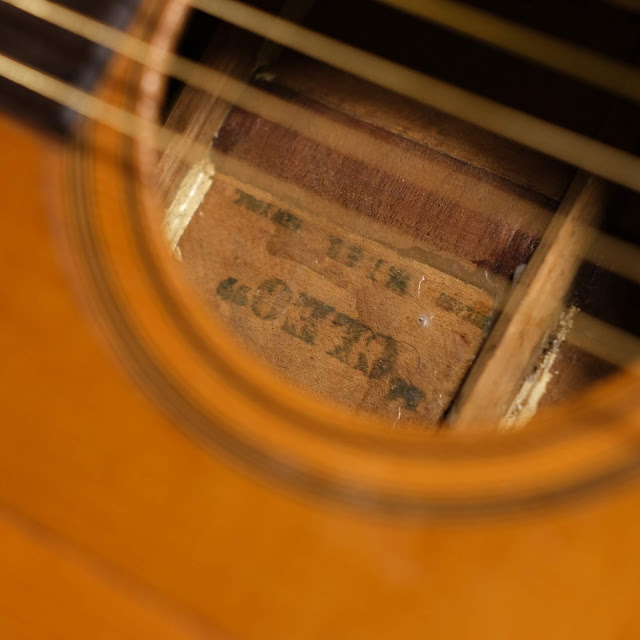1890s Cleo Birdseye Maple Parlor Guitar
This gorgeous little guitar is owned by a friend of mine. His mother-in-law played it some time back and it had a number of horrid repairs attempted by his father-in-law (also some while ago), but said friend brought it here to get fixed-up so it'd be stable and play correctly.
While I can't confirm the maker, this thing is built in many ways identically to Haynes/Bay State builds from the 1870s/1880s era. There are many features that are similar to my own Haynes-made Tilton guitar, including a tenon joint for the neck, similar neck feel, and similar overall cut. There are other things that diverge from that maker, though, so I'm not sure if it is one at all, but it's safe to assume, I think, that it's at least a Boston-made instrument and probably dates to the 1880s but I'll say 1890s to be safe. The only other makers I know of that favored tenon joints of this one's style were Vega and, to some extent, Bauer.
This guitar has a "Cleo" brand in the soundhole but offers no other clues. The interior has been manhandled a bit, though most of the original bracing is still extant. The body is nice in that it has a solid spruce top and extremely-figured solid birdseye maple for the back and sides. The top edge is bound in rosewood, too.
It has a sweet, clean, clear tone and the maple's reflectivity and balance really suits the nylon/gut strings this guitar needs to stay healthy. It was definitely not built for steel strings.
Repairs included: a neck reset and dual-neck-bolt installation, fret level/dress, side dots install, modification to the bridge, replacement main ladder brace below the soundhole (the original was broken so I installed a new one but set at a "transverse" angle like a Regal-made guitar to open-up the tone), crack repairs to the top, seam repairs, some brace reglue work, cleaning, new bridge pins, a new bone saddle and expansion of the saddle slot, and a setup.
Setup notes: the neck is straight and it plays perfectly with hair-under 3/32" action at the 12th fret. It's strung with LaBella Gold 900s with polished basses and their sweetness and silkiness is a good mix with the guitar's clear tone.
Scale length: 24 1/2"
Nut width: 1 3/4"
String spacing at nut: 1 9/16"
String spacing at bridge: 2 3/16"
Body length: 18 1/4"
Lower bout width: 12 3/4"
Waist width: 7 1/4"
Upper bout width: 9"
Side depth at endpin: 3 1/2"
Top wood: solid spruce
Back/sides wood: solid birdseye maple
Neck wood: mahogany
Bracing type: ladder w/transverse main brace
Fretboard: Brazilian rosewood, bone nut
Bridge: Brazilian rosewood, bone saddle
Neck feel: slim-med C/V shape, flat board
Condition notes: there are a lot of shabby old repairs on the interior rear and definitely some muck at the center back seam externally, some uglier seam repairs to the back/sides, some marking-up at the back of the neck on the heel, some funky cracks near the fretboard extension on the top, and some marking-up on the fretboard. Oh -- also note those terrible classical-style clear pickguards. Oof!
The original nut was gone so I fit this small bone one.
The original saddle would've been a fret saddle, but over the years it had been modified to use a bigger piece of wire. I simply recut it to suit a slotted bone saddle for easy adjustability and better tone.
How about that birdseye? It's gorgeous!
The neck's tenon joint is only about 1/8" deep into the body, so I reinforce these with two (under/over) neck bolts concealed at the neckblock.
The bone-buttoned, handmade-brass-plate tuners are in great shape and look lovely.

















Comments